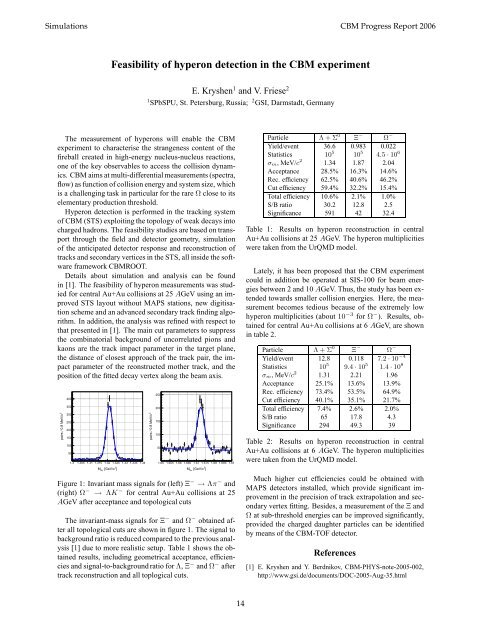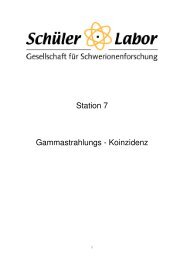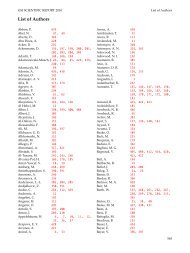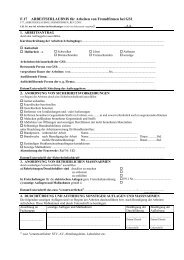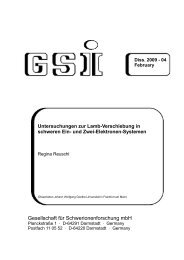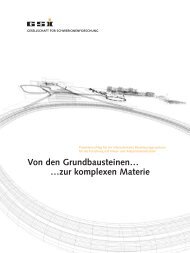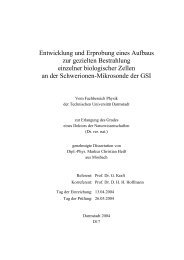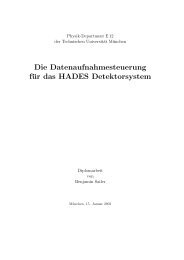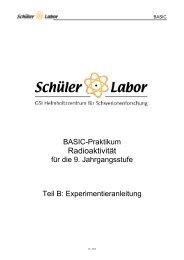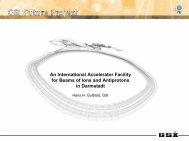CBM Progress Report 2006 - GSI
CBM Progress Report 2006 - GSI
CBM Progress Report 2006 - GSI
Create successful ePaper yourself
Turn your PDF publications into a flip-book with our unique Google optimized e-Paper software.
Simulations <strong>CBM</strong> <strong>Progress</strong> <strong>Report</strong> <strong>2006</strong><br />
Feasibility of hyperon detection in the <strong>CBM</strong> experiment<br />
The measurement of hyperons will enable the <strong>CBM</strong><br />
experiment to characterise the strangeness content of the<br />
fireball created in high-energy nucleus-nucleus reactions,<br />
one of the key observables to access the collision dynamics.<br />
<strong>CBM</strong> aims at multi-differential measurements (spectra,<br />
flow) as function of collision energy and system size, which<br />
is a challenging task in particular for the rare Ω close to its<br />
elementary production threshold.<br />
Hyperon detection is performed in the tracking system<br />
of <strong>CBM</strong> (STS) exploiting the topology of weak decays into<br />
charged hadrons. The feasibility studies are based on transport<br />
through the field and detector geometry, simulation<br />
of the anticipated detector response and reconstruction of<br />
tracks and secondary vertices in the STS, all inside the software<br />
framework <strong>CBM</strong>ROOT.<br />
Details about simulation and analysis can be found<br />
in [1]. The feasibility of hyperon measurements was studied<br />
for central Au+Au collisions at 25 AGeV using an improved<br />
STS layout without MAPS stations, new digitisation<br />
scheme and an advanced secondary track finding algorithm.<br />
In addition, the analysis was refined with respect to<br />
that presented in [1]. The main cut parameters to suppress<br />
the combinatorial background of uncorrelated pions and<br />
kaons are the track impact parameter in the target plane,<br />
the distance of closest approach of the track pair, the impact<br />
parameter of the reonstructed mother track, and the<br />
position of the fitted decay vertex along the beam axis.<br />
2<br />
pairs / 0.8 MeV/c<br />
400<br />
350<br />
300<br />
250<br />
200<br />
150<br />
100<br />
50<br />
1.3 1.305 1.31 1.315 1.32 1.325 1.33 1.335 1.34<br />
2<br />
Minv<br />
[GeV/c ]<br />
E. Kryshen 1 and V. Friese 2<br />
1 SPbSPU, St. Petersburg, Russia; 2 <strong>GSI</strong>, Darmstadt, Germany<br />
2<br />
pairs / 0.8 MeV/c<br />
250<br />
200<br />
150<br />
100<br />
50<br />
1.65 1.655 1.66 1.665 1.67 1.675 1.68 1.685 1.69<br />
2<br />
Minv<br />
[GeV/c ]<br />
Figure 1: Invariant mass signals for (left) Ξ − → Λπ − and<br />
(right) Ω − → ΛK − for central Au+Au collisions at 25<br />
AGeV after acceptance and topological cuts<br />
The invariant-mass signals for Ξ − and Ω − obtained after<br />
all topological cuts are shown in figure 1. The signal to<br />
background ratio is reduced compared to the previous analysis<br />
[1] due to more realistic setup. Table 1 shows the obtained<br />
results, including geometrical acceptance, efficiencies<br />
and signal-to-background ratio for Λ, Ξ − and Ω − after<br />
track reconstruction and all toplogical cuts.<br />
14<br />
Particle Λ + Σ 0<br />
Ξ −<br />
Ω −<br />
Yield/event 36.6 0.983 0.022<br />
Statistics 10 5<br />
10 5<br />
4.5 · 10 6<br />
σm, MeV/c 2<br />
1.34 1.87 2.04<br />
Acceptance 28.5% 16.3% 14.6%<br />
Rec. efficiency 62.5% 40.6% 46.2%<br />
Cut efficiency 59.4% 32.2% 15.4%<br />
Total efficiency 10.6% 2.1% 1.0%<br />
S/B ratio 30.2 12.8 2.5<br />
Significance 591 42 32.4<br />
Table 1: Results on hyperon reconstruction in central<br />
Au+Au collisions at 25 AGeV. The hyperon multiplicities<br />
were taken from the UrQMD model.<br />
Lately, it has been proposed that the <strong>CBM</strong> experiment<br />
could in addition be operated at SIS-100 for beam energies<br />
between 2 and 10 AGeV. Thus, the study has been extended<br />
towards smaller collision energies. Here, the measurement<br />
becomes tedious because of the extremely low<br />
hyperon multiplicities (about 10 −3 for Ω − ). Results, obtained<br />
for central Au+Au collisions at 6 AGeV, are shown<br />
in table 2.<br />
Particle Λ + Σ 0<br />
Ξ −<br />
Ω −<br />
Yield/event 12.8 0.118 7.2 · 10 −4<br />
Statistics 10 5<br />
9.4 · 10 5<br />
1.4 · 10 8<br />
σm, MeV/c 2<br />
1.31 2.21 1.96<br />
Acceptance 25.1% 13.6% 13.9%<br />
Rec. efficiency 73.4% 53.5% 64.9%<br />
Cut efficiency 40.1% 35.1% 21.7%<br />
Total efficiency 7.4% 2.6% 2.0%<br />
S/B ratio 65 17.8 4.3<br />
Significance 294 49.3 39<br />
Table 2: Results on hyperon reconstruction in central<br />
Au+Au collisions at 6 AGeV. The hyperon multiplicities<br />
were taken from the UrQMD model.<br />
Much higher cut efficiencies could be obtained with<br />
MAPS detectors installed, which provide significant improvement<br />
in the precision of track extrapolation and secondary<br />
vertex fitting. Besides, a measurement of the Ξ and<br />
Ω at sub-threshold energies can be improved significantly,<br />
provided the charged daughter particles can be identified<br />
by means of the <strong>CBM</strong>-TOF detector.<br />
References<br />
[1] E. Kryshen and Y. Berdnikov, <strong>CBM</strong>-PHYS-note-2005-002,<br />
http://www.gsi.de/documents/DOC-2005-Aug-35.html


